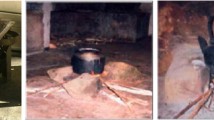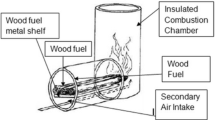Abstract
The paper presents results of a study conducted to identify and modify the prevalent traditional multipot cookstoves in rural areas of Maharashtra, India. The flaws in the existing traditional stoves were identified through a survey comprising measurement of geometrical features of different specimens in the field and face-to-face interaction with the end-users. The end-users answered a structured questionnaire including the information about existing cooking practices, per day fuel consumption, willingness to adapt to a new stove type and related things. A popular model was then modified to develop an improved multipot cookstove, which was compared against the popular cookstove by conducting a set of experiments. The parameters evaluated during the experimentation were specific fuel consumption, burning rate, thermal efficiency, time taken to do a specific cooking task and CO emissions. It was found that the modifications to the popular stove resulted in increase in thermal efficiency, decrease in burning rate and specific fuel consumption but a decrease of firepower and turn-down ratio. The activity resulted in developing a better cookstoves for the targeted community.








Similar content being viewed by others
Abbreviations
- CO:
-
Carbon monoxide
- LPG:
-
Liquefied petroleum gas
- WBT:
-
Water boiling test
- TMBC:
-
Traditional multipot biomass cookstove
- IMBC:
-
Improved multipot biomass cookstove
- LCV:
-
Lower calorific value
- SFC:
-
Specific fuel consumption
- FP:
-
Firepower
- TDR:
-
Turn-down ratio
References
Adkins, E., Tyler, E., Wang, J., Sirriri, D., & Modi, V. (2010a). Field testing and survey evaluation of household biomass cookstoves in rural sub-Saharan Africa. Energy for Sustainable Development, 14, 172–185.
Adkins, E., Chen, J., Winiecki, J., Koinei, P., & Modi, V. (2010b). Testing institutional biomass cookstoves in rural Kenyan schools for the Millennium Villages Project. Energy for Sustainable Development, 14, 186–193.
Agenbroad, J. (2010). A simplified model for understanding natural convection driven biomass-cooking stoves (MS thesis). Colorado: Colorado State University, Department of Mechanical Engineering.
Agenbroad, J., DeFoort, M., Kirkpatrick, A., & Kreutzer, C. (2011a). A simplified model for understanding natural convection driven biomass-cooking stoves e part 1: Setup and baseline validation. Energy for Sustainable Development, 15, 160–168.
Agenbroad, J., DeFoort, M., Kirkpatrick, A., & Kreutzer, C. (2011b). A simplified model for understanding natural convection driven biomass cooking stoves part 2: With cook piece operation and the dimensionless form. Energy for Sustainable Development, 15, 169–175.
Alam, S. M. N., & Chowdhury, S. J. (2010). Improved earthen stoves in coastal areas in Bangladesh: Economic, ecological and socio-cultural evaluation. Biomass and Bioenergy, 34, 1954–1960.
Arora, P., Jain, S., & Sachdeva, K. (2014). Laboratory based assessment of cookstove performance using energy and emission parameters for North Indian cooking cycle. Biomass and Bioenergy, 69, 211–221.
Bailis, R., Ogle, D., MacCarty, N., & Still, D. (2003–2007). The water boiling test (WBT) version 3.0 and accompanying data calculation spreadsheet. Household Energy and Health Programme, Shell Foundation. https://www.k4health.org/sites/default/files/WBT_Version_3.0_Jan2007a.pdf. Accessed 16 January 2017.
Baldwin, S. F. (1988). Biomass stoves: Engineering design development and dissemination. Arlington, VA: Vita Publications.
Ballard-Tremeer, G. (1997). Emissions of rural wood-burning cooking devices. Ph.D. Thesis. Faculty of Engineering, University of the Witwatersrand, Johannesburg.
Bhattacharya, S. C., Albina, D. O., & Khaing, A. M. (2002a). Effects of selected parameters on performance and emission of biomass- red cookstoves. Biomass and Bioenergy, 23, 387–395.
Bhattacharya, S. C., Albina, D. O., & Salam, P. A. (2002b). Emission factors of wood and charcoal-fired cookstoves. Biomass and Bioenergy, 23, 453–469.
Callahan C. (1999). Rainforest Deforestation, Rainforest Information Centre, RIC, 2000A. http://kanat.jsc.vsc.edu/student/callahan/mainpage.htm. Accessed on 1 November 2017.
Geremew, K., Gedefaw, M., Dagnew, Z., & Jara, D. (2014). Current level and correlates of traditional cooking energy sources utilization in urban settings in the context of climate change and health, Northwest Ethiopia: A case of Debre Markos Town. biomed research international: 572473. https://www.hindawi.com/journals/bmri/2014/572473/.
Government of India. Ministry of new and renewable Energy (MNRE). http://mnre.gov.in/schemes/grid-connected/biomass-powercogen/. Accessed 15 May 2017.
Grabow, K., Still, D., & Bentson, S. (2013). Test Kitchen studies of indoor air pollution from biomass cookstoves. Energy for Sustainable Development, 17, 458–462.
Granderson, J., Sandhu, J. S., Vasquez, D., Ramirez, E., & Smith, K. R. (2009). Fuel use and design analysis of improved wood burning cookstoves in the Guatemalan Highlands. Biomass and Bioenergy, 33, 306–315.
Hankey, S., Sullivan, K., Kinnick, A., Koskey, A., Grande, K., Davidson, J. H., et al. (2015). Using objective measures of stove use and indoor air quality to evaluate a cookstove intervention in rural Uganda. Energy for Sustainable Development, 25, 67–74.
Honkalaskar, V. H., Bhandarkar, U. V., & Sohoni, M. (2013). Development of a fuel efficient cookstove through a participatory bottom–up approach. Energy, Sustainability and Society, 3, 16.
Joshi, M., & Srivastava, R. K. (2013). Development and performance evaluation of an improved three pot cook stove for cooking in rural Uttarakhand, India. International Journal of Advanced Research, 1(5), 596–602.
Kaoma, J., & Kasali, G. B. (1994). Efficiency and emission characteristics of two Zambia cookstoves using charcoal and coal briquettes. Reports in the energy, environment & development (EE&D) series-36, Stockholm Environment Institute (SEI) in collaboration with the Swedish International Development Cooperation Agency (SIDA), Stockholm, Sweden.
Kshirsagar, M. P. (2009). Experimental study for improving energy efficiency of charcoal stove. Journal of Scientific & Industrial Research, 68, 412–416.
Kshirsagar, M. P., & Kalamkar, V. R. (2014). A comprehensive review on biomass cookstove and a systematic approach for modern cookstove design. Renewable and Sustainable Energy Reviews, 30, 580–603.
Kshirsagar, M. P., & Kalamkar, V. R. (2015). A mathematical tool for predicting thermal performance of natural draft biomass cookstoves and identification of a new operational parameter. Energy, 93, 188–201.
Kshirsagar, M. P., & Kalamkar, V. R. (2016). User-centric approach for the design and sizing of natural convection biomass cookstoves for lower emissions. Energy, 115, 1202–1215.
Kumar, M., Kumar, S., & Tyagi, S. K. (2013). Design, development and technological advancement in the biomass cookstoves: A review. Renewable and Sustainable Energy Reviews, 26, 265–285.
Lombardi, F., Riva, F., Bonamini, G., Barbieri, J., & Colombo, E. (2017). Laboratory protocols for testing of improved cooking stoves (ICSs): A review of state-of-the-art and further developments. Biomass and Bioenergy, 98, 321–335.
MacCarty, N., Still, D., & Ogle, D. (2010). Fuel use and emissions performance of fifty cooking stoves in the laboratory and related benchmarks of performance. Energy for Sustainable Development, 14(3), 161–171.
Maharashtra Population Census. (2011). http://www.census2011.co.in/census/state/districtlist/maharashtra.html. Accessed on 18 May 2017.
Mehetre, S. A., Panwar, N. L., Sharma, D., & Kumar, H. (2017). Improved biomass cookstoves for sustainable development: A review. Renewable and Sustainable Energy Reviews, 73, 672–687.
Nzihou, J. F., Hamidou, S., Bouda, M., Koulidiati, J., & Segda, B. G. (2014). Using Dulong and Vandralek formulas to estimate the calorific heating value of a household waste model. International Journal of Scientific & Engineering Research, 5(1), 2229–5518.
Oanh, N. T. K., Albina, D. O., Ping, L., & Wang, X. (2005). Emission of particulate matter and polycyclic aromatic hydrocarbons from select cookstove–fuel systems in Asia. Biomass and Bioenergy, 28, 579–590.
Pennise, D., Brant, S., Agbeve, S. M., Quaye, W., Mengesha, F., Tadele, W., et al. (2009). Indoor air quality impacts of an improved wood stove in Ghana and an ethanol stove in Ethiopia. Energy for Sustainable Development, 13(2), 71–76.
Report “Two Pot Rocket Lorena Uganda”, submitted by GTZ, German Technical Cooperation (GTZ) Energy Advisory Project, Uganda. https://energypedia.info/images/7/74/Draft_rocket_lorena_uganda_stove_fact_sheet-lf-ed.pdf. Accessed on 22 June 2017.
Samson, R., Stohl, D., Elepano, A., & Maio A. D. (2001). Enhancing household biomass energy use in the Philippines-chapter 2: Strategies for enhancing biomass utilization in the Philippines. National Research Laboratories Subcontract Number AXE-0-30001-01. https://www.reap-canada.com/online_library/IntDev/idmts/3%20Enhancing%20Household.PDF. Accessed on 20 June 2017.
Sedighi, M., & Salarian, H. (2017). A comprehensive review of technical aspects of biomass cookstoves. Renewable and Sustainable Energy Reviews, 70, 656–665.
Shen, G. (2016). Changes from traditional solid fuels to clean household energies—Opportunities in emission reduction of primary PM2.5 from residential cookstoves in China. Biomass and Bioenergy, 86, 28–35.
Singh, S., Gupta, G. P., Kumar, B., & Kulshrestha, U. C. (2014). Comparative study of indoor air pollution using traditional and improved cooking stoves in rural households of Northern India. Energy for Sustainable Development, 19, 1–6.
Singh, A., Tuladhar, B., Bajracharya, K., & Pillarisetti, A. (2012). Assessment of effectiveness of improved cook stoves in reducing indoor air pollution and improving health in Nepal. Energy for Sustainable Development, 16, 406–414.
Smith, K. R., & Sagar, A. (2014). Making the clean available: Escaping India’s chulha trap. Energy Policy, 75, 410–414.
Still, D., & MacCarty, N. Test results of cook stove performance, Aprovecho Shell Foundation United States Environmental Protection Agency. https://www.pciaonline.org/resources/test-results-cook-stove-performance. Accessed on 21 June 2017.
Still, D., MacCarty, N., Ogle, D., Bond, T., & Bryden, M. (2011). Test results of cook stove performance. Cottage Grove, OR: Aprovecho Research Centre. London: Shell Foundation; Washington DC: U.S. Environmental Protection Agency.
Suresh, R., Singh, V. K., Malik, J. K., Datta, A., & Pal, R. C. (2016). Evaluation of the performance of improved biomass cooking stoves with different solid biomass fuel types. Biomass and Bioenergy, 95, 27–34.
Sutar, K. B., Kohli, S., Ravi, M. R., & Ray, A. (2015). Biomass cookstoves: A review of technical aspects. Renewable and Sustainable Energy Reviews, 41, 1128–1166.
World Energy Outlook (WEO). International Energy Agency. (2016). http://www.worldenergyoutlook.org/resources/energydevelopment/energyaccessdatabase/. Accessed 15 May 2017.
World Health Organization. Household Health and Air pollution. (2014). Accessed 1 November 2017. http://www.who.int/mediacentre/factsheets/fs292/en/.
Yuntenwi, E., MacCarty, N., Still, D., & Jurgen, E. (2008). Laboratory Study of the effects of moisture content on heat transfer and combustion efficiency of three types of biomass cook stoves. Energy for Sustainable Development, 12(2), 66–77.
Acknowledgements
We are grateful to all the people from the surveyed rural areas, for opening their homes and hearts for us while conducting the survey. A special thanks to Senior Technician V. C. Bhujade (VNIT, Nagpur) for helping with the fabrication of experimental setup.
Author information
Authors and Affiliations
Corresponding author
Ethics declarations
Conflict of interest
The authors declare that they have no conflicts of interest.
Electronic supplementary material
Below is the link to the electronic supplementary material.
Rights and permissions
About this article
Cite this article
Pande, R.R., Kalamkar, V.R. & Kshirsagar, M. Making the popular clean: improving the traditional multipot biomass cookstove in Maharashtra, India. Environ Dev Sustain 21, 1391–1410 (2019). https://doi.org/10.1007/s10668-018-0092-4
Received:
Accepted:
Published:
Issue Date:
DOI: https://doi.org/10.1007/s10668-018-0092-4




